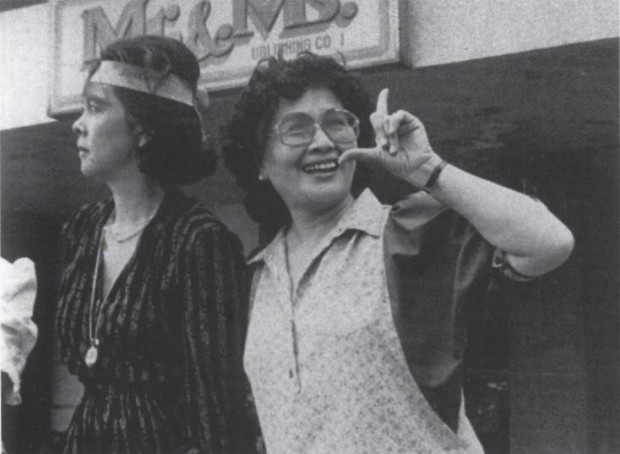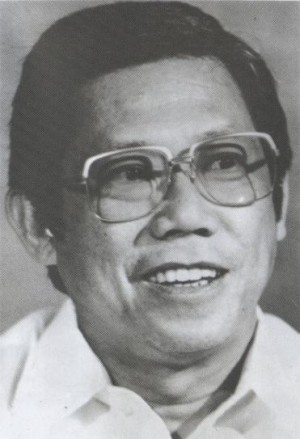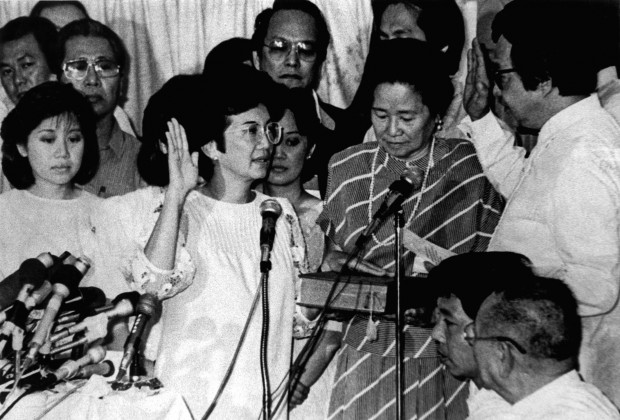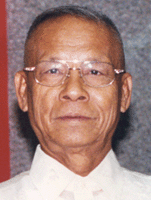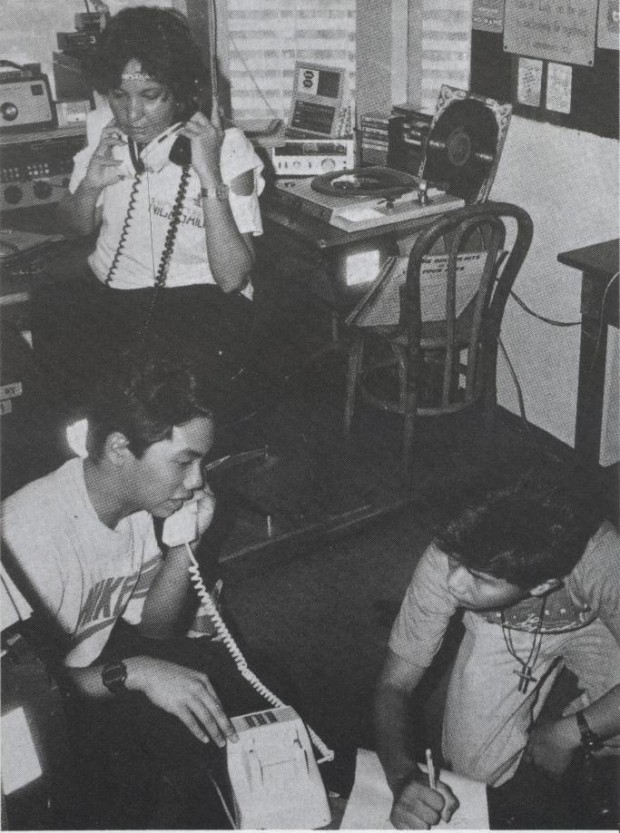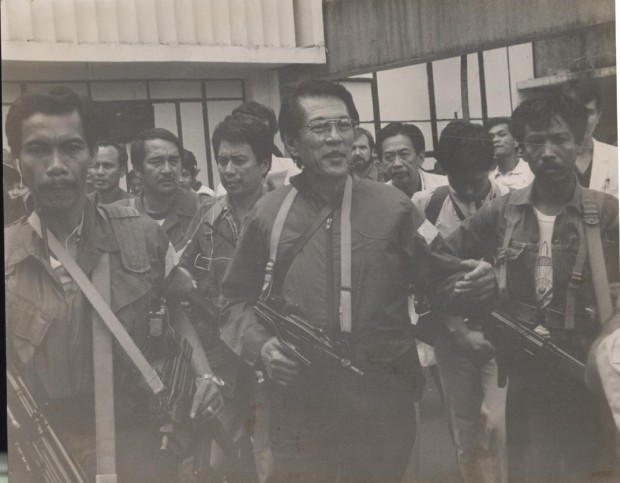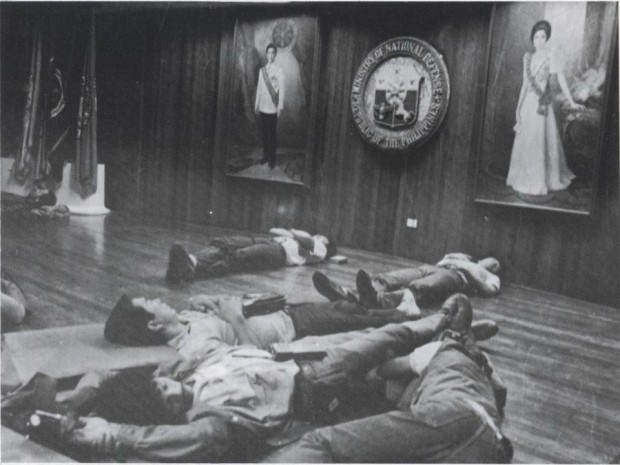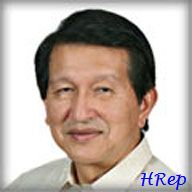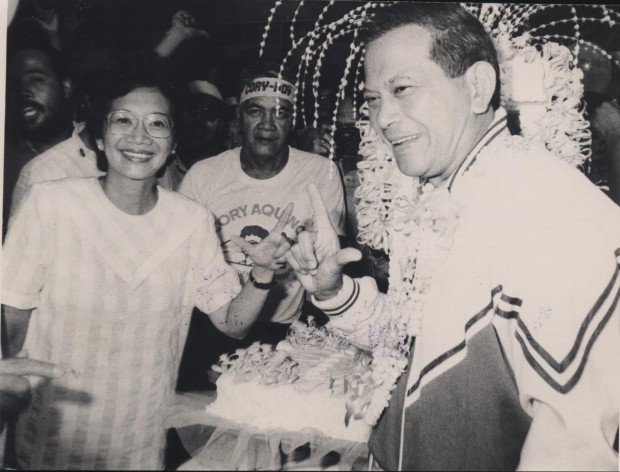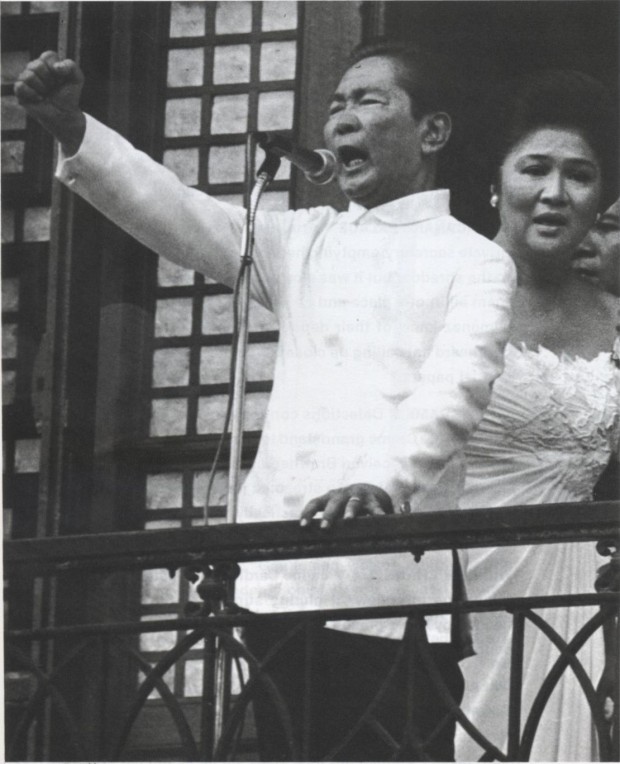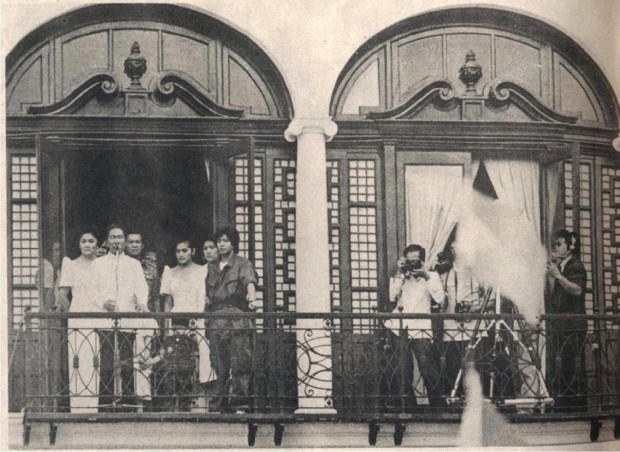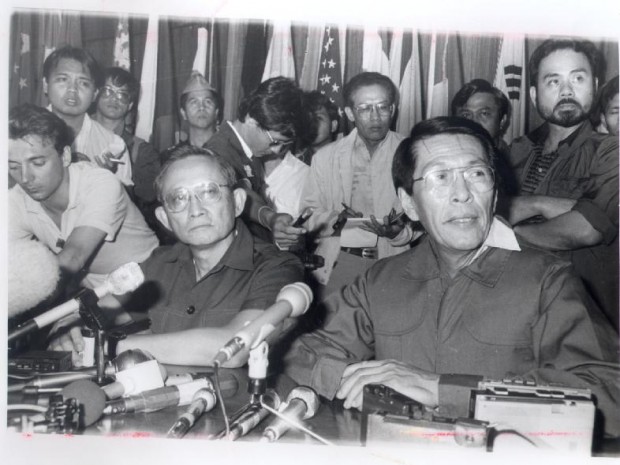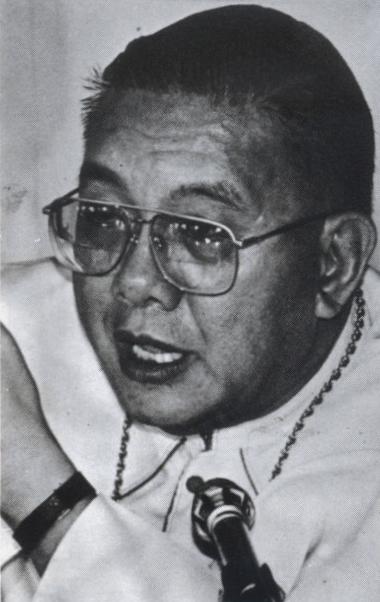The ‘Who’s who?’ of Edsa, and where they are now
Thousands made possible the historic Edsa People Power Revolution on Feb. 22 to 25, 1986. Some of them remain familiar names in recent headlines, while some have been seemingly forgotten.
Here are some of Edsa’s key personalities–in alphabetical order–and the roles they played in changing Philippine history during those four crucial days.
1. COL. JOSE ALMONTE. One of the founders of Reform the Armed Forces Movement (RAM), who warned then opposition leader Corazon Aquino, her brother Jose Cojuangco and Jaime Cardinal Sin about an impending event on the third week of February 1986. He also offered to provide security to Aquino. In RAM’s planned coup d’etat, two groups would attack Malacañang and capture then President Marcos. Almonte’s assignment, along with Lt. Col. Victor Batac, was to man the RAM command post at Nichols Field, where a battalion from Trece Martires in Cavite would join them. The coup was aborted when Marcos discovered the plot a day before its launching. Subsequent events led to the Edsa revolt. Almonte was the first to be promoted general by Aquino when she assumed the presidency. After he retired from military service, Aquino appointed him head of the Economic Intelligence and Investigation Bureau. He was also the chief security adviser of President Fidel Ramos from 1992 to 1998. He launched his book “Endless Journey, a Memoir” last year.
2. EUGENIA APOSTOL. Founding chair of the Philippine Daily Inquirer and publisher of the tabloid Mr. & Ms Special Editions, two of the leading papers that openly opposed the Marcos regime. On the afternoon of Day 1, Feb. 22, Apostol was in the Inquirer office when she got a call from Cristina Enrile, wife of then Defense chief Juan Ponce Enrile, informing her about the latter’s arrest. “Will you help us? Will you call the cardinal for us?” she asked Apostol, who then called the Archbishop’s Palace but failed to talk to him. Apostol told colleagues Betty Go Belmonte and Lita Logarta to find a way to get in touch with the cardinal, while she dashed off to the Enriles’ house in Dasmariñas Village. She also told then Inquirer editor in chief, Louie Beltran, about the call, which led to the newspaper being in the midst of the Filipino people’s unfolding big story which was developing so fast that the Inquirer had to publish three Extra editions (on Feb. 23, 24 and 25, 1986) to report the news as soon as it happened.
3. AGAPITO ‘BUTZ’ AQUINO. A founding member of the August 21 Movement (Atom), which was set up after the 1983 assassination of his brother, Ninoy Aquino. It was Butz who first rallied people to go to Edsa, after declaring Atom’s support for the Enrile-Ramos group. Over the radio, he asked other anti-Marcos groups to convene at Cindy’s fast food on Aurora Boulevard in Cubao. Atom members were among the first to do so. Aquino served in the Senate from 1987-1995. He passed away at the age of 76 on Aug. 17, 2015.
4. CORAZON AQUINO. Widow of Sen. Benigno “Ninoy” Aquino Jr., the staunchest critic of Marcos, who emerged as the leader of the opposition after he was assassinated on Aug. 21, 1983 on his return from exile in the US. When Marcos called for snap presidential elections in late 1985, she was drafted as opposition candidate, with former Sen. Salvador Laurel as her vice president. Marcos was proclaimed winner in the elections held on Feb. 7, 1986, amidst allegations of widespread fraud and violence. Aquino disputed the results in a Tagumpay ng Bayan (People’s Victory) rally at Rizal Park attended by at least four million supporters, where she vowed to lead a civil disobedience campaign and a boycott of crony-owned businesses to force Marcos to step down. On Feb. 25, Day 4 of the Edsa uprising, she took her oath as president before Supreme Court Senior Justice Claudio Teehankee at Club Filipino. She served as President until 1992. She was honored as Time’s Woman of the Year in 1986, and later, as one of Time’s 60 Asian Heroes in 2006. She died on Aug. 1, 2009 after a 16-month battle with colon cancer. She was 76.
5. RODOLFO BIAZON. A Marine commander based in Davao City who was convinced by businessman Chito Ayala to protect Corazon Aquino in her supposed civil disobedience campaign in the city. Biazon’s aide had learned of the plans and was ordered by his superiors to shoot Biazon if he defects. Biazon was declared on the radio to have defected to the side of Enrile and Ramos. But reports later revealed that he had actually not. After the EDSA revolt, he became the commanding general of the Marines and eventually rose to become the AFP chief of staff in 1991. Known as one of the military officers who stayed loyal to Aquino, he helped quash the 1987 and 1989 coup attempts staged by military rebels. A year later, he won a seat in the Senate, and then held two consecutive terms from 1998 to 2010. Currently on his second term as a representative of Muntinlupa City, he is running for senator under the Liberal Party in the coming elections.
6. BRAULIO BALBAS JR. A deputy commandant of the Philippine Marines during Edsa, two battalions under him were given the mission of assaulting and seizing the Ministry of Defense Building at Camp Aguinaldo. He was repeatedly ordered by Maj Gen Josephus Ramas, then commanding general of the Philippine Army, to fire his howitzers at Camp Crame. Balbas hesitated and reported that he was still positioning the howitzers. Balbas’ decision not to fire his howitzers was a critical moment that eventually led to the peaceful end of the crisis. He retired as head of Western Command in Palawan with the rank of brigadier general.
7. JUNE KEITHLEY-CASTRO. Radio broadcaster during the Edsa revolt who gave the Filipinos a blow-by-blow account of the revolution despite prevailing media censorship. After announcing their breakaway from Marcos on Feb. 22, Enrile and Ramos asked Fr. James Reuter to have someone go on air to give guidance to the people. Reuter sent Keithley to the Church-run Radio Veritas, which had broadcast Cardinal Sin’s historic appeal for the people to go to Edsa. After government forces shut down Radio Veritas, Keithley and her team moved to the dzRJ facilities in Sta. Mesa. To keep their location secret, the group used the Veritas’ frequency of 840 and took the name “Radyo Bandido.” She passed away on Nov. 24, 2014 after a lingering battle with cancer. She was 66.
8. JUAN PONCE ENRILE. Marcos’ defense secretary and central political figure in the coup plot against him with rebel troops from RAM. It was planned at 2 a.m. of Feb. 23, 1986, but was discovered the day before. Hours after the discovery, Enrile withdrew support from Marcos along with Fidel Ramos, then vice chief of the Armed Forces of the Philippines. They also recognized Aquino as the duly elected President. He was among those charged with rebellion and murder for his alleged participation in a military coup against President Aquino in December 1989. He served as senator from 1987 to 1992, 1995 to 2001, 2004 to 2010 and 2010 to present. He was also briefly a representative of Cagayan’s 1st District (1992 to 1995). He was Senate President from November 2008 to June 2013. In July 2014, Enrile was indicted for plunder for allegedly pocketing P173 million in kickbacks for allowing the diversion of his pork barrel allocation to ghost projects and fake foundations connected with businesswoman Janet Lim-Napoles. He was later detained at PNP General Hospital and was able to return to the Senate in August after being granted bail. He is 92 years old.
9. FOREIGN PRESS. The Manila-based foreign correspondents went straight to Camp Aguinaldo on the night of Feb. 22 upon learning about the failed coup plot and stayed with Enrile and his mutineers. Their presence emboldened Enrile to warn Marcos the next day against killing him, lest he “go down in history as butchers of your own officers and men, of the Filipino people, and of foreign mediamen.” A number of them wrote books on Martial Law and Edsa, like the late Time Magazine foreign correspondent Sandra Burton, who wrote “Impossible Dream.”
10. ROILO GOLEZ. Appointed by Marcos as Postmaster General in 1981, he served as head of the post office for many years. Before and after the Feb. 7, 1986 election, he was everywhere on TV predicting a Marcos victory. But on Feb. 22, 1986, Golez arrived at Camp Aguinaldo to support Defense Secretary Juan Ponce Enrile and AFP vice chief Gen. Fidel Ramos. Former AFP chief Romeo Espino and Brig. Gen. Ramon Farolan were also there. He surprised Filipinos when he later read his irrevocable resignation over the radio. He became the first senior government official to officially resign from the Marcos administration after Enrile and Ramos. Post-Marcos regime, Golez was elected in the Congress as the representative of the lone district of Parañaque in 1992. He served consecutive terms until 2001. He served as the National Security Adviser of former President Gloria Macapagal-Arroyo from 2001 to 2004. He was re-elected as representative in 2004 and served consecutive terms again until 2013.
11. GREGORIO HONASAN. Enrile’s chief security aide cofounded the RAM with four others in 1982 following reports of plans to eliminate Enrile and the “MND (Ministry of National Defense) boys.” Also one of the masterminds behind the Malacañang assault, together with Col. Eduardo Kapunan and Col. Victor Batac. On learning that Malacañang had fortified its troops against RAM, Honasan and Kapunan convinced Enrile to fly to Cagayan and hide, but Enrile instead decided to regroup at Camp Aguinaldo. He has been tagged in the November 1986, July 1987 and December 1989 coup attempts against the Corazon Aquino administration and was imprisoned for some time. He was granted amnesty in 1995, the same year he won in the senatorial elections. He is currently running for vice president as Vice President Jejomar Binay’s running mate.
12. EDUARDO KAPUNAN. An original member of RAM, Air Force Lt. Col. Eduardo “Red” Kapunan was one of the few AFP officers who openly went against Marcos early on. According to the RAM plot, Kapunan and Lt. Col. Rodolfo Aguinaldo would lead the group who would attack the Presidential Guards on the south bank of the Pasig River. His group would complement Honasan’s smaller assault team who was to capture Marcos at dawn of Feb. 23. When the plot was uncovered, Kapunan and other RAM members took a last stand in Camp Aguinaldo with Enrile.
13. SALVADOR “DOY” LAUREL. The former senator organized the opposition during the martial law years and gave up his presidential ambitions in favor of Corazon Aquino in the 1986 snap elections that preceded Edsa. On Feb. 25, Day 4, he was sworn in as vice president and was appointed prime minister in the Cory government. In September 1987, Laurel resigned the foreign affairs post, citing differences with Ms Aquino on the insurgency and other issues. He died of lymphoma on Jan. 28, 2004.
14. ALFREDO LIM. Metropolitan Police chief who ignored orders to disperse the crowds at Edsa who were there to protect the rebels holed up at Camp Crame. Malacañang had sent tanks to assault Crame but could not get through the crowds. Lim’s order was to disperse the crowd of less than 1000 with the 800 policemen he had with him on Day 2, but he refused. On Feb. 25, Lim and his men entered Camp Crame and were welcomed by Ramos. Lim was mayor of the Manila from 1992 to 1998 and 2007 to 2013. He also served as senator from 2004 to 2007. He is currently running for Manila mayor under the Liberal Party in the upcoming elections.
15. FERDINAND MARCOS. Elected president in 1965, Marcos declared martial law in September 1972 and stayed on as president until his ouster during the People Power Revolution in 1986. His twenty-year rule was marked with thousands of cases of human rights violations, torture, deaths and disappearances. With the signing of Republic Act No. 10368, or the Human Rights Victims Reparation and Recognition Act, in February 2013, more than 75,000 persons (as of May 2015) have come forward to file their claims as human rights violations victims of martial rule (1972-1986), or as next of kin of victims who have suffered, died or disappeared during those dark years under the dictator. Marcos died in exile in Hawaii on Sept. 28, 1989. A Transparency International Global Corruption Report has listed Marcos as among the world’s most corrupt leaders, having embezzled some $5 to 10 billion during his term.
16. IMELDA MARCOS. She was initially reluctant to leave the Palace and seemed in denial about the situation. After Marcos’ oath-taking ceremonies at the Malacañang Ceremonial Hall on Feb. 25, 1986, whose television coverage had been abruptly cut off by rebel allies, the Marcoses took to the balcony and waved to their supporters. An impeccably groomed Imelda led the crowd in singing “Dahil Sa Iyo.” She also handed out payroll envelopes with P10,000 each to the remaining Palace personnel before they left. She was exiled in Hawaii with her husband after their ouster in 1986. She was first elected to Congress in 1995. She is seeking a third term in Congress as a representative of the second district of Ilocos Norte in the upcoming elections. According to the Presidential Commission on Good Government, the former First Lady’s jewelry collections, seized by the government after the fall of the dictatorship, are now worth at least P1 billion.
17. FERDINAND “BONGBONG” MARCOS JR. Only son among three children of Ferdinand Sr. and Imelda. Dressed in fatigues, he acted like a security agent to the sickly dictator as they left the Palace on the evening of Feb. 25, 1986. Since their family’s return from exile, Marcos has served as congressman of Ilocos Norte’s 2nd district (1992-1995, 2007-2010) and Ilocos Norte governor for three consecutive terms (1998-2007). Elected to the Senate in 2010, he is currently running for vice president as Sen. Miriam Defensor-Santiago’s running mate.
18. IMEE MARCOS-MANOTOC. Marcos’ eldest daughter was in tears with sister Irene, pleading with their father to leave for the US amid his vow to die in the Palace. Her husband Tommy Manotoc had relayed the offer of US Brig. Gen. Ted Allen for them to use American helicopters or boats to move Marcos out. The incumbent Ilocos Norte governor is running for re-election in the upcoming elections.
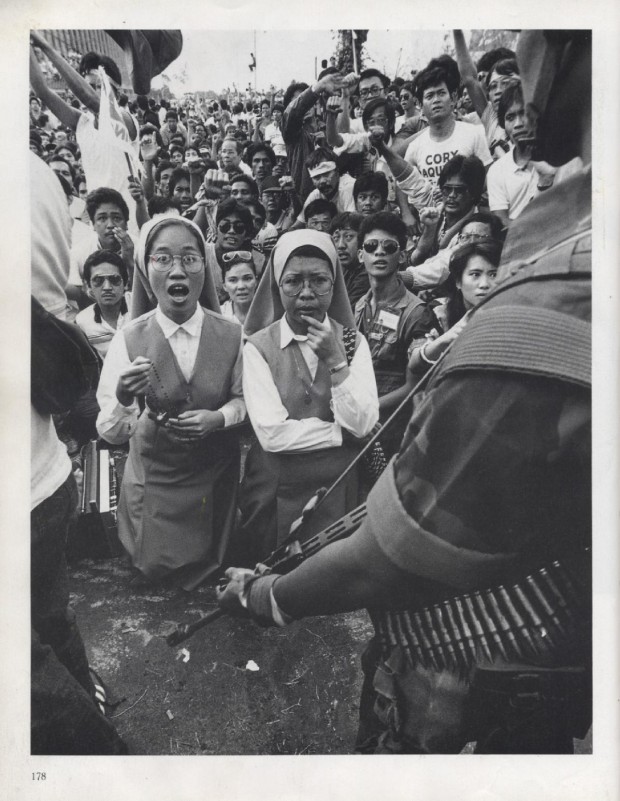
Nuns were among those who stopped tanks to protect protesters on Edsa in 1986. Photo Source: People Power: An Eyewitness History.
19. NUNS STOPPING TANKS. Heeding Cardinal Sin’s call for them to protect the breakaway groups, members of religious orders trooped to Edsa, among them Religious of the Sacred Heart nuns Maribel Carceller, Digna Dacanay and Edy Talastas, who were among the first to get there. Like other religious groups, they distributed food to the soldiers, led in praying the rosary and as shown in subsequent photos, kneeled in front of tanks to stop forces loyal to Marcos.
20. PROSPERO OLIVAS. Senior general of the Metropolitan Command who was unable to carry out Marcos’ orders to bomb Radyo Veritas (the only station airing live coverage of Edsa) and to disperse the crowd at EDSA, saying it was beyond his troops’ control. Before EDSA, he was accused of being one of 26 linked to the Aquino assassination.
21. FIDEL RAMOS. The former chief of the Philippine Constabulary (forerunner of today’s Philippine National Police) and Armed Forces vice chief of staff withdrew support from Marcos and joined Enrile’s planned coup as leader of military and police operations. When he heard the premature news that Marcos had left Malacañang on the third day of Edsa, Ramos jumped with joy, an iconic image he would use in his presidential bid in 1992. He served as President until 1998.
22. FR. JAMES REUTER, SISTER SARAH MANAPOL, PABLO AND GABE MERCADO. Keithley, Reuter and Manapol ran the clandestine “Radyo Bandido,” which broadcast updates of the events unfolding at Edsa from Feb. 22 to 25, despite threats of arrest from the pro-Marcos military. Pablo and Gabe Mercado (then 13 and 15 years old, respectively) were the volunteers who helped Keithley at the secret station, while Sister Sarah Manapol provided the information for broadcast. Fr. Reuter passed away on Dec. 31, 2012. He was 96 years old.
23. JAIME CARDINAL SIN. The Archbishop of Manila became a driving force in ousting Marcos when he sounded the clarion call for people to mass at Edsa to defend the rebels led by Enrile and Ramos. Although it was Butz Aquino who made the first call for people power, even he acknowledged that it was Sin who packed them at Edsa. From about 2,000 people midnight on Day One, the crowd swelled to 100,000 by noon of Day Two, thanks to the Cardinal’s call. Sin, who was honored as ‘Liberator of Filipinos’, died on June 21, 2005.
24. ANTONIO SOTELO. This former Air Force chief turned the tide in favor of the rebels when he led the defection of the Air Force’s 15th Strike Wing, ignoring Marcos’ order for them to disable the helicopters in the rebel-held Camp Crame on Feb. 24. Sotelo’s defection came at a decisive moment, just after a Marcos loyalist Marine detachment had infiltrated Camp Aguinaldo and set up artillery and mortars across Edsa, from where the rebel forces were holed up. Sotelo was among the first officers promoted to general by Aquino. He became Air Force chief in February 1987 and was AFP vice chief of staff with the rank of lieutenant general when he retired in August 1989.
25. FABIAN VER. Armed Forces Chief of Staff loyal to Marcos who was accused of rewarding loyalty instead of merit. On Feb. 22, Day One of the revolt, US Ambassador to the Philippines Stephen Bosworth and Philip Habib, US President Ronald Reagan’s “trouble-shooter” told Marcos of the worsening political crisis and the need to remove Ver from office. A Marcos loyalist to the very end, Ver fortified the Palace on learning of the impending coup by RAM. He also ordered that Radio Veritas be destroyed and that troops loyal to Marcos launch a final “suicide assault” against the rebel forces on the afternoon of Feb. 24. He and his family fled to Hawaii with the Marcoses on the evening of Feb. 25. He was charged by the majority members of the Agrava Fact-Finding Board as a principal in the double murder of Ninoy Aquino and Rolando Galman. But in late 1985, the Sandiganbayan acquitted him and other military respondents. Ver was charged as an accomplice in a new trial ordered by the Supreme Court. But he was not tried in his absence and the case against him has been shelved. On Nov. 21, 1998, Ver died of a lung ailment in Bangkok, where he had been living in exile for four years.
Compiled by Kathleen de Villa, Rafael L. Antonio, Marielle Medina, Kate Pedroso and Minerva Generalao, Inquirer Research
Sources: Inquirer Archives, senate.gov.ph, congress.gov.ph, Chronology of A Revolution by Angela Stuart-Santiago, Ferdinand Marcos: Malacañang to Makiki by Arturo Aruiza











